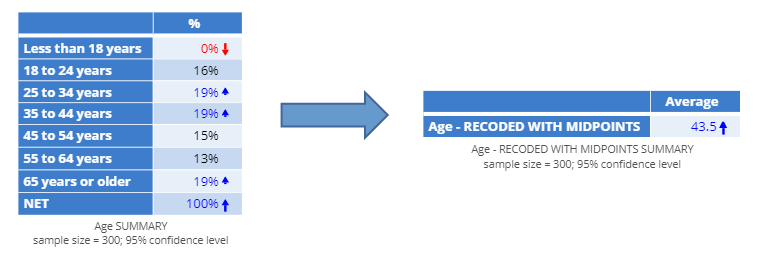Create New Variables - Numeric Variable(s) from Code/Category Midpoints
This tool automatically recodes the labels of categorical variables into new numeric variables, quantifying the information contained within the labels of input variable(s).
To apply the same recoding without generating new variables, use Recoding - Recode Variable(s) Using Code/Category Midpoints instead.
Example
Technical details
This QScript creates a new Number or Number - Multi question]] for each input question which can be a Pick One, Pick One - Multi, Number, or Number - Multiquestion that have numbers or ranges of numbers in their labels. It attempts to set values for each category that correspond to the numbers in the labels or midpoints of that category.
Where labels contain a single number, this value will be used. If no number is detected in the label, then the value of NaN will be assigned. Recoding will only be applied for questions that have three or more labels containing numbers.
Where the label contains a range of numbers, for example 18 to 24 then the midpoint value will be used (for example 21 in this case). If a question is recoded according to mid-points and it contains a lower label like Less than 18 then the midpoint will be half-way between zero and the number in the label (in this example 9). When the question is recoded according to mid-points and it contains an upper label like 55 or more then the midpoint will be the number in the label plus half of the previous interval - so if the previous interval was 50 to 54 this midpoint will be set to 57. If no midpoint for a label can be determined then a value of NaN will be assigned.
If the labels include any kind of brackets, e.g. [[ or (, then only the text inside the brackets will be used. If there is no closing bracket (the label has been truncated) then everything after the opening bracket will be used.
Labels that contain references to time periods, such as days, weeks, minutes, and hours, or other units like litres or kilograms are difficult to recode in this way, because the presence of units often leads to different scales for different categories. Any such questions will be added to a separate folder in your report.
How to apply this QScript
- Start typing the name of the QScript into the Search features and data box in the top right of the Q window.
- Click on the QScript when it appears in the QScripts and Rules section of the search results.
OR
- Select Automate > Browse Online Library.
- Select this QScript from the list.
Customizing the QScript
This QScript is written in JavaScript and can be customized by copying and modifying the JavaScript.
Customizing QScripts in Q4.11 and more recent versions
- Start typing the name of the QScript into the Search features and data box in the top right of the Q window.
- Hover your mouse over the QScript when it appears in the QScripts and Rules section of the search results.
- Press Edit a Copy (bottom-left corner of the preview).
- Modify the JavaScript (see QScripts for more detail on this).
- Either:
- Run the QScript, by pressing the blue triangle button.
- Save the QScript and run it at a later time, using Automate > Run QScript (Macro) from File.
Customizing QScripts in older versions
JavaScript
▶ Show Code
See also
- QScript for more general information about QScripts.
- QScript Examples Library for other examples.
- Online JavaScript Libraries for the libraries of functions that can be used when writing QScripts.
- QScript Reference for information about how QScript can manipulate the different elements of a project.
- JavaScript for information about the JavaScript programming language.
- Table JavaScript and Plot JavaScript for tools for using JavaScript to modify the appearance of tables and charts.
